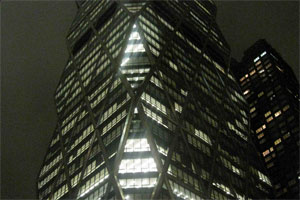 This is a LEED-certified building on Columbus Circle
This is a LEED-certified building on Columbus Circle
in New York City. Anything wrong with this picture?The Leadership in Energy and Environmental Design (LEED) program has been around for many years, and has became a well-known "brand" among builders, developers and much of the general public nationwide. The program was developed and is administered by the U.S. Green Building Council (USGBC). There are LEED certifications (certified, silver, gold, and platinum) for commercial and residential buildings, building retrofits, and the USGBC is developing a LEED certification for neighborhoods. The focus of LEED is to mark buildings (and now neighborhoods) that are sustainable, healthy, and energy efficient. The program has become so popular and well known that many cities now require that new municipal buildings be built to LEED standards.
But there is some question as to whether LEED buildings actually save energy. Henry Gifford, an engineer and mechanical system designer in New York City, "...the best data available shows that on average, they (LEED-certified buildings) use more energy than comparable buildings." His view is controversial, but I have seen the data he used and have studied his analysis and it seems reasonable to me, though I am not a statistician and have done a limited amount of number crunching in my short career as an engineer before becoming a writer.
I have heard the arguments from the other side and haven't been convinced. Even from a common sense perspective, it seams unrealistic that LEED buildings are built to save energy. I've seen too many LEED certified buildings with a large percentage of windows as exterior walls--that is like trying to build an energy efficient building without walls. Also, LEED certification does not require performance testing of buildings. A building can achieve points for energy efficiency from modeling alone. In my role as editor of Home Energy Magazine, I have wanted to publish in-depth articles about LEED-certified homes, but I have been unable to find a LEED-certified building owner or designer who is willing to publish a full year of performance data, post-occupancy.
The LEED program has made green building a common term and a sought after designation among architects, builders, and developers across the nation. LEED buildings may use more environmentally friendly materials and be healthier for their occupants. But it is not yet clear to me that they save energy compared to business as usual. If we want to achieve energy independence, combat the worst effects of global warming, and grow a green economy, we can't afford to build--and celebrate--buildings built as usual.
37.8686 -122.267
